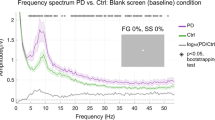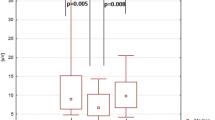Abstract
We investigated the effects of single doses of the dopamine agonist levodopa and the dopamine antagonist haloperidol on pattern and flash electroretinograms (ERGs) and visual evoked potentials (VEPs) in normal subjects. A placebo and two treatment regimens were administered in a randomized double-masked design. No significant intertreatment differences in the pattern ERGs and VEPs were noted. Although not statistically significant, a clearly discernible tendency was found for increased flash ERG b-wave amplitudes after levodopa administration compared with placebo. In comparison with placebo and levodopa, haloperidol was associated with significantly prolonged flash ERG b-wave implicit times, including each oscillatory potential, which also showed increased duration, particularly in the O1–O3 interpeak implicit time. The failure of pattern ERGs and VEPs to show changes after haloperidol may have been related to the timing of the recordings, which took place during the presumed phase of rising blood levels and before the flash ERG and VEP recordings. Our findings further demonstrated the reliability of the flash ERG in revealing changes in dopaminergic status in the visual system and suggest that steady-state (flicker) ERGs, cone ERGs, and oscillatory potentials have particular use in this regard.
Similar content being viewed by others
Abbreviations
- C-ERG:
-
Cone dominated ERG
- M-ERG:
-
‘mixed’ rod and cone ERG
- R-ERG:
-
rod dominated ERG
- S-ERG:
-
steady-state (flicker) ERG
- OP:
-
oscillatory potential
- P-ERG:
-
pattern-reversal ERG
- F-VEP:
-
flash visual evoked potential
- P-VEP:
-
pattern reversal visual evoked potential
- RCT:
-
retinocortical time
References
Castrogiovanni P, Marazziti D. ERG b-wave amplitude and brain dopaminergic activity. Am J Psychiatry 1989; 146: 1085–1086.
Bodis-Wollner I, Yahr MD, Mylin L, Thornton J. Dopaminergic deficiency and delayed visual evoked potentials in humans. Ann Neurol 1982; 11: 478–483.
Bartel P, Blom M, van der Meyden C, Sommers de K. Effects of single doses of diazepam, chlorpromazine, imipramine and trihexyphenidyl on visual-evoked potentials. Neuropsychobiology 1988; 20: 212–217.
Fornaro P, Castrogiovanni P, Perossini M, Placidi GF, Cavallacci G. Electroretinography (ERG) as a tool of investigation in human psychopharmacology. Electroretinographic changes induced by a combination of carbi-dopa and levo-dopa. Acta Neurol (Napoli) 1980; 4: 293–299.
Fornaro P, Dell'osso L, Perossini M, Placidi GF, Castrogiovanni P. Effects of nomifensine on dopaminergic transmission in healthy volunteers evaluated by means of the electroretinographic technique. Acta Neurol (Napoli) 1984; 6: 5–10.
Bartel P, Blom M, Robinson E, van der Meyden C, Sommers de K, Becker P. Effects of chlorpromazine on pattern and flash ERGs and VEPs compared to oxazepam and to placebo in normal subjects. Electroencephalogr Clin Neurophysiol, in press.
Volavka J, Cooper TB. Review of haloperidol blood level and clinical response: Looking through the window. J Clin Pharmacol 1987; 7: 25–30.
Cedarbaum JM. Clinical pharmacokinetics of anti-Parkinsonian drugs. Clin Pharmacokinet 1987; 13: 141–178.
Holley FO, Magliozzi JR, Stanski DR, Lombrozo L, Hollister LE. Haloperidol kinetics after oral and intravenous doses. Clin Pharmacol Ther 1983; 33: 477–484.
Celesia GG, Kaufman D. Pattern ERGs and visual evoked potentials in maculopathies and optic nerve diseases. Invest Ophthalmol Vis Sci 1985; 26: 726–735.
Bresnick GH, Korth K, Groo A, Palta M. Electroretinographic oscillatory potentials predict progression of diabetic retinopathy. Arch Ophthalmol 1984; 102: 1307–1311.
Nguyen-Legros J, Savy C. Dopamine innervation of the vertebrate retina: Morphological studies. In Bodis-Wollner I, Piccolino M, eds. Dopaminergic mechanisms in vision. New York: Alan R Liss, 1988: 1–17.
Ellis CJK, Allen TGL, Marsden CD, Ikeda H. Electroretinographic abnormalities in idiopathic Parkinson's disease and the effect of levodopa administration. Clin Vis Sci 1987; 1: 347–355.
Nakagawa T, Kurasaki S, Masuda T, Ukai K, Kubo S, Kadono H. Effects of some psychotropic drugs on the b-wave of the electroretinogram in isolated rabbit retina. Jpn J Pharmacol 1988; 46: 97–100.
Rang HP, Dale MM. Pharmacology. London: Churchill Livingstone, 1987: 504.
Jaffe MJ, Bruno G, Campbell G, Lavine RA, Karson CN, Weinberger DR. Ganzfeld electroretinographic findings in Parkinsonism: Untreated patients and the effect of levodopa intravenous infusion. J Neurol Neurosurg Psychiatry 1987; 50: 847–852.
Onofrj M, Bodis-Wollner I. Dopaminergic deficiency causes delayed visual evoked potentials in rats. Ann Neurol 1982; 11: 484–490.
Marmor MF, Hock P, Schechter G, Pfefferbaum A, Berger PA, Maurice R. Oscillatory potentials as a marker for dopaminergic disease. Doc Ophthalmol 1988; 69: 255–261.
Author information
Authors and Affiliations
Rights and permissions
About this article
Cite this article
Bartel, P., Blom, M., Robinson, E. et al. The effects of levodopa and haloperidol on flash and pattern ERGs and VEPs in normal humans. Doc Ophthalmol 76, 55–64 (1990). https://doi.org/10.1007/BF00140498
Accepted:
Issue Date:
DOI: https://doi.org/10.1007/BF00140498




